

The disciplines and precepts of Chanwu Federation International consist of martial virtues, Chanwu disciplines and precepts.
Wu (martial) refers to specific abilities and artistic skills to be learnt by a student, which demands the physique or the external abilities of a student. De (virtues) refers to moral and behavioral correctness, which demands the spiritual or the internal of a student. Wude or martial virtues, are the ethics and code of conducts that a martial arts practitioner shall follow in daily and social life. Different schools of Gong Fu or martial arts styles may regulate specific moral or behavioral codes: however, the martial virtues always serve as the basis.
The purpose and requirement of martial arts practice for the students of Chanwu Federation International shall be practicing martial arts while holding virtues in esteem; and strengthening the body while cultivating the mind. The harmony of the body and the mind is the martial virtue that a martial arts practitioner shall attain in order to maintain the integrity of his personality.
Being a genuine Chanwu Federation student requires austere observation of the disciplines and precepts of Chanwu Federation International.
"Greeting-theMaster Salute" is a term and behavioral etiquette unique in the field of martial arts. It primarily symbolizes respectfulness towards people senior in age or status. It is also used by people of the same generation as a greeting with cultural implications accepted by all martial arts practitioners. In Chanwu Federation, greeting-the-master salute combines the Buddhist palm-pressed-together salute (He Shi Li in Chinese) and the Wushu palm-to-fist salute (Bao Quan Li in Chinese).
Before the training starts, all students stand in one line facing Shifu (or Shiheng or Jiaolian). First the students greet the Shifu (or Shiheng or Jiaolian) with palms-pressed-together salute and say "Amitobha!" then with palm-to-fist salute and say, "Shifu (or Shiheng or Jiaolian), Nihaol" At the end of the training, the same greetings will be extended with the difference of Zaijian (Goodbye) instead of Nihao.
In Chanwu Federation, this salute indicates high esteem towards people senior in age or status; respect towards people of the same generation and modesty towards people of younger generation.
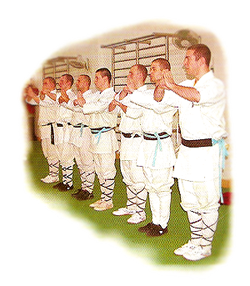
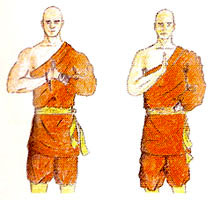
Performance : Stand with feet together, press both palms naturally in front of the chest and bow slightly. This salute can be done with both palms pressed together or with one single palm.
Origin and Meaning : This salute comes from namaste, the Buddhist greeting, meaning boundless blessings and light, symbolizing peace, humbleness, friendliness and auspice. Chanwu students shall use this salute when entering or leaving the training premise.
Performance: Form the left hand into the palm with the left thumb bend toward the middle of the palm and stretch the other four fingers. Form the right hand into a fist with the thumb touching the second and third digital joints of the index and middle fingers. Stand with feet together and press left palm to the right fist at chest level with ease about 20 to 30 cm away from the chest. The top of the knuckles shall be in line with the bottom of the left-hand fingers. The arms shall be in an embracing position with dropped elbows. When "saluting, the person shall hold his head upright, look to the person being saluted, with natural and pleasant facial expressions.

This salute comes from the traditional Chinese greeting, Zuo Yi Li and four-finger greeting used by Shaolin school martial artists. Palm-to-Fist salute is standardized by International Wushu Federation and used by martial arts practitioners in competitions and performances.
The right fist refers to martial power, symbolizing strength and the will for refinement and progress in martial arts practice. The five fingers closed into a fist form also implied the "Five Lakes".
The left palm refers to morals and wisdom, symbolizing knowledge and martial ethics. The bent thumb indicates that the martial arts practitioner shall hold himself in modesty and humbleness and never place himself above others. The four fingers also imply the "Four Seas".
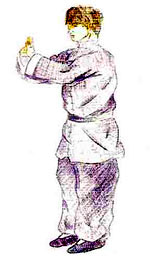


Left palm pressed to the right fist in an embracing position referring to Five Lakes and Four Seas ("Wu Hu Si Hai" in Chinese), symbolizing the whole world or specifically the martial arts community. The second meaning is that martial arts are media for friendship building and that people from martial arts community unite in humbleness and solidarity like a family.
The combination of the left palm as intellectual and the right fist as martial indicates the integrity of both scholarly and martial arts learning that a martial artist shall seek. It symbolizes modesty, the will to seek knowledge and guidance from the masters as well as respectfulness towards masters and fellow students. The embracing position of the arms serves as a wanting to martial arts practitioners against the improper application of martial skills. The two Chinese terms, "to be brave yet to be controlled" and "to be martial yet not to break the rules" mean to keep one's martial skills under good control and to avoid the abuse of them. This salute also embodies Chanwu Federation's wish to build a harmonious, modest and progressive community, in which the unity of Chan and Wu will bring happiness and health to everybody.
Stand with feet together. Hold the saber in the left hand and hold the right hand as in the palms-pressed-together salute, 20 to 30 cm from the chest.
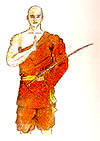
Stand with feet together. Hold the sword horizontally in the left hand as in the reverse grip and place the hand with the sword at the back with bent elbow. Hold the right hand as in the palms-pressed-together salute, 20 to 30 cm from the chest.
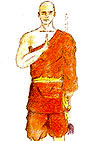
Stand with feet together. Hold the staff at its rear section with right hand and stretch the arm horizontally to right forward direction with the staff on the right shoulder. Hold the left hand as in the palms-pressed-together salute, 20 to 30 cm from the chest.
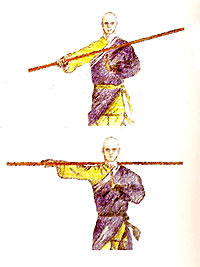
Stand with feet together. Hold the spear at its grip section with right hand and stretch the arm horizontally to the right forward direction with the spear on the right shoulder. Hold the left hand as in the palms-pressed-together salute, 20 to 30 cm from the chest.
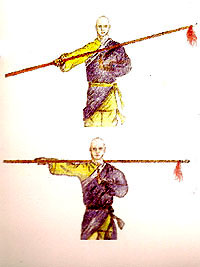
2025 Chan Wu Canada. All Rights Reserved.
Site by · Les Zurlus